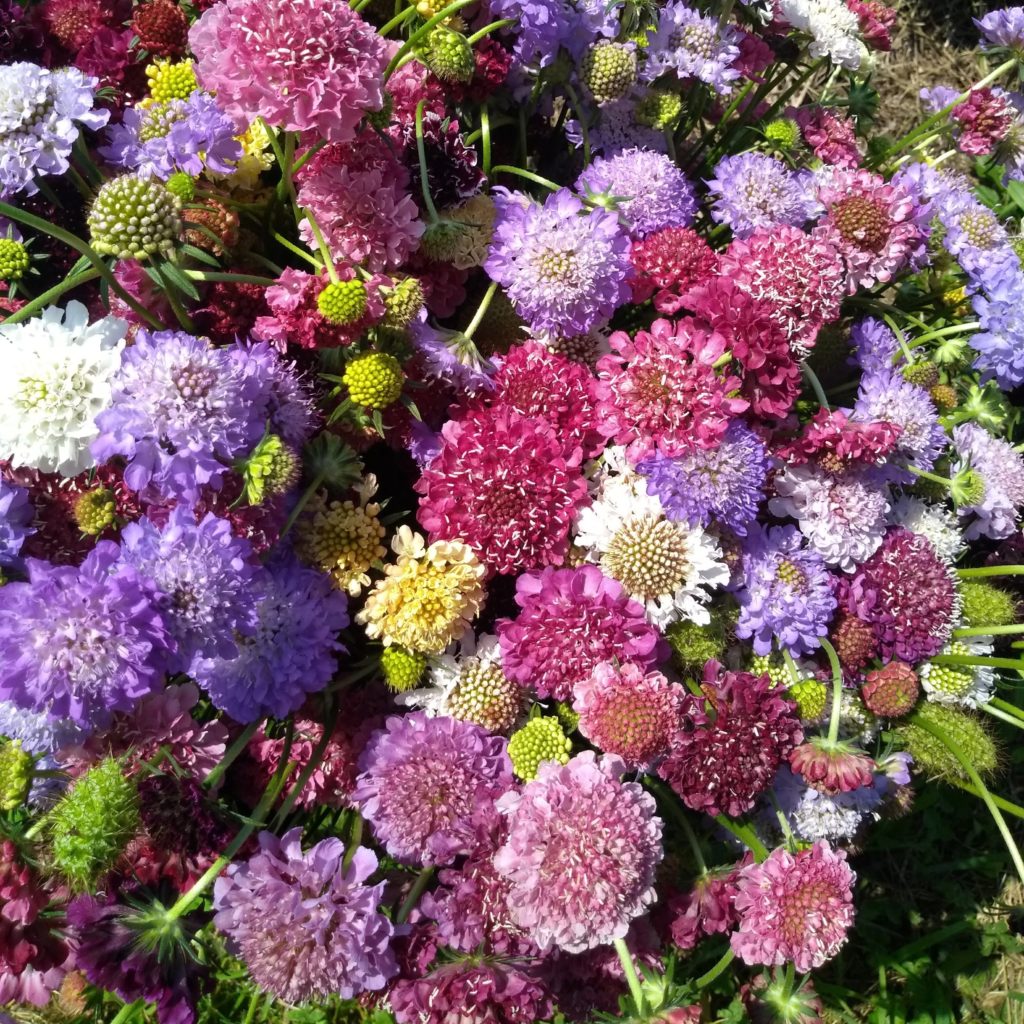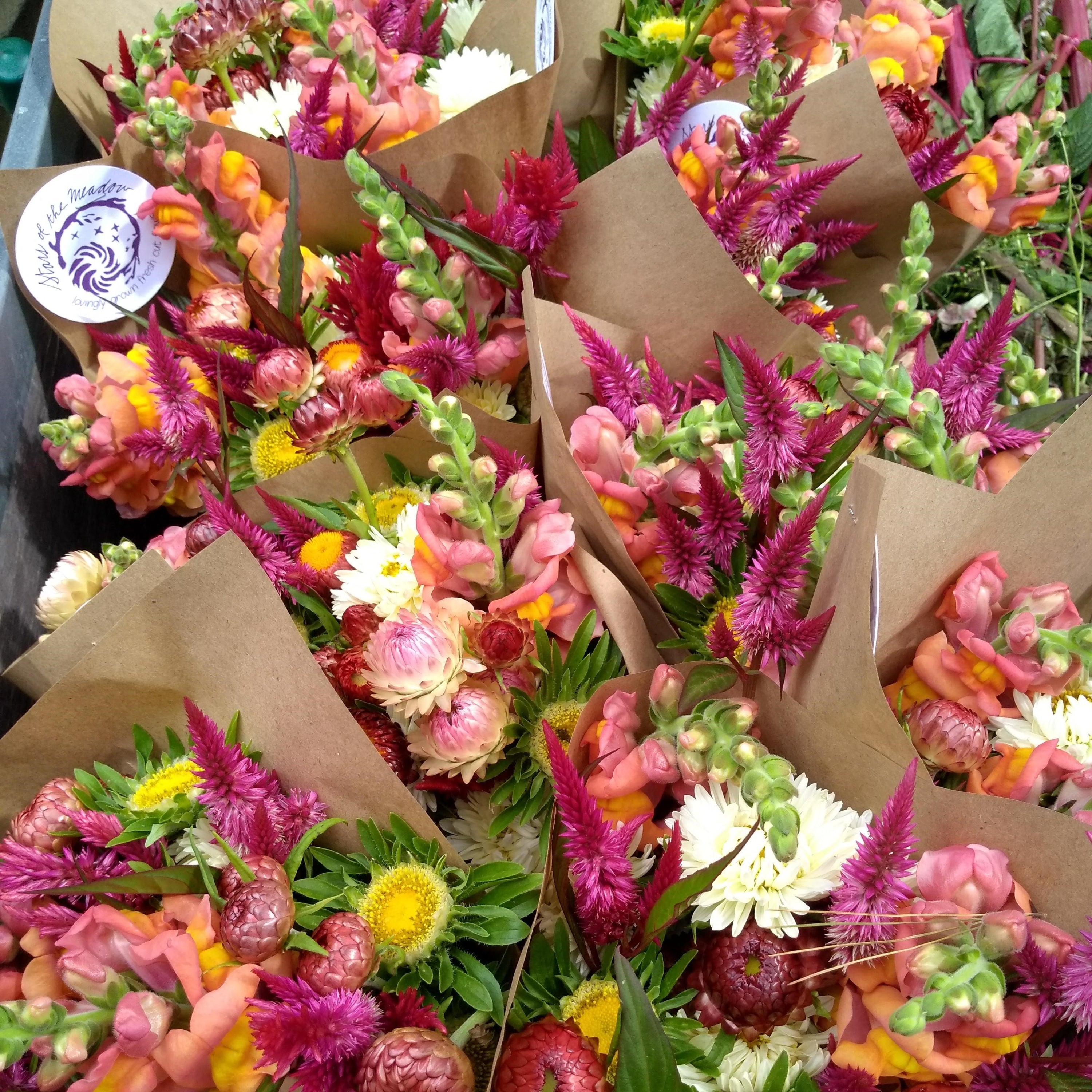We hope you’ve been enjoying our Grower to Grower series where we meet local farmers in our community and learn from their experience and expertise. This week, we met with our friend Marybeth Wehrung, owner of Stars of the Meadow flower farm. Marybeth not only farms less than half a mile down the road from us, she’s a regular face at our seed company. She's given us invaluable advice about the flower varieties we grow here on the farm, and she gave our team a training last fall on how best to prepare and store our (newly in stock!) certified organic dahlia tubers.
Marybeth runs a small-scale flower farm that offers locally and sustainably grown specialty cut flowers and foliage to florists, event designers, retailers, and DIY Wedding couples in the mid Hudson Valley.
 Marybeth at her farm with farm cat Sheena
Marybeth at her farm with farm cat SheenaMarybeth, we know you as an organic flower farmer who uses no-till methods. How did you arrive here and why are these methods important to you?
“I arrived at using Organic and no till methods from a background in permaculture and regenerative agriculture, and my trust in the wisdom of soil when we leave it minimally disturbed. I understood the theory of building soil structure 'like the forest does' by layering the forest floor with carbon (leaves, branches, carcases) and the teeming biology below ground, and saw this borne out in many sheet mulched gardens I've had. So I decided to try farming like gardener, with no uncovered soil, and have found it to be an efficient way to sequester organic matter, carbon, minerals, water, and most importantly, microbial and mycelial pathways- all of which get disturbed through disruptions like plowing, tilling, and weed cultivation. It's spiritual, yet also very practical. Because of this, no tractors or machinery are needed, and hand tools and human power do most of the work. And this farm happens to be woman owned with an additional female employee, so it's woman powered.”
 Stars of the Meadow flower bouquets
Stars of the Meadow flower bouquetsContributing to the regional floral supply is an important aspect of your work. What should people know about the floral industry and where do you see Stars of the Meadow farm fitting into it?
“When I began growing cut flowers here, I wanted to answer a question for myself. It was "Can I impact my local economy by supplying cut flower and foliage material to florists and flower lovers, and begin to limit the wasteful and sometimes dangerous import of flowers from around the world in to my own community?" There is no definite answer yet, but I began to sell to local florists and at farmers’ markets. I'm not sure if I am replacing product from abroad exactly, but I like to think that by offering something locally grown and in season, less money and resources are funding cheap flown-in flowers that are produced under questionable conditions and at the risk of human health and welfare. For my wedding DIY customers, couples are choosing to buy seasonal and locally sourced flowers for their event instead of from wholesalers, florists and others who may use some US grown product, but can't boast such a low carbon footprint as being grown in the same town, or within a 30 minute drive from their venue. “
What traits do you most value in the flowers you grow?
The traits I most value in the flowers I grow are (in no particular order): gorgeous color, texture, form, and sometimes fragrance, stem length and strength, a long vase life, ease of culture and handling, a long harvest window, multiple yields (blooms, then seed pods later in the season, for example), and general vigor and robustness.

What top 3 varieties do you most recommend to growers starting out? And are there any new varieties you are excited to try on your farm this year?
Top annual varieties I recommend to beginners would include zinnias and sunflowers, which are easy to direct sow or start indoors. I'd also recommend Scabiosa (pictured right), Agrostemma, Calendula, Flowering Basils, Snapdragons and Celosia. Many perennials make great cut flowers too, including Peony, Lupine, Delphinium, Veronica, Columbine, Yarrow, Hellebores, Alliums and more.
To test something as a cut flower, cut a nice long stem at a cool time of day, before the bloom(s) are fully open, put directly in water in a cool spot, and watch how it behaves. If it doesn't flop and lasts 5 days or more, it passes the test!
I'm excited about a couple of new Dahlia varieties this season as dahlias are always my favorite (pictured below). I'm also looking forward to a cream calendula, and also the 3rd year of growth on a peony planting, the year you can really begin harvesting.

What are you top ‘cut flower’ growing tips for growers of any size operation?
 China Asters
China Asters- Plan a few successions. For things like Zinnias, which are cut and come again, you may only need one planting, but to keep cutting all season long, plant things at multiple intervals throughout the season so you have new things coming in to bloom all the time.
- Also pay attention to days to bloom on websites and packages. This is how you can calculate when to plant and when you'll start cutting.
- At harvest time, go out early before it warms up. Find blooms that are beginning to open but not fully open. Cut long stems deep in to the plant with a sharp pair of snips, strong scissors or bypass pruners, and put directly in to water. Keep cut flowers out of direct light and extreme temperatures, change the water daily, and your bouquets should last 5-7 days.
- When arranging, I like to think about texture and form, with at least 3 items of varying height and shape. Choose 'focal' flowers, like zinnias, dahlias, sunflowers, and be sure to include some filler or spray types, and a spike flower for height. Don't overlook foliage! Ornamental grasses, herbs, small branches, 'weeds', wildflowers, etc can all be used in your arranging.
Learn more about Marybeth's farm and her gorgeous flowers at www.starsofthemeadow.com





